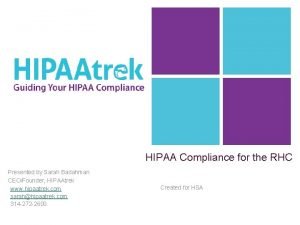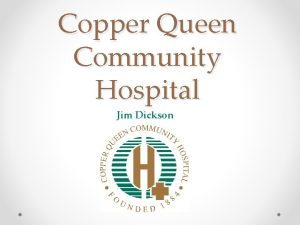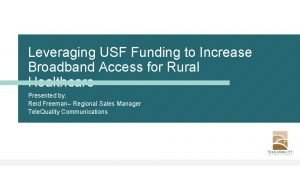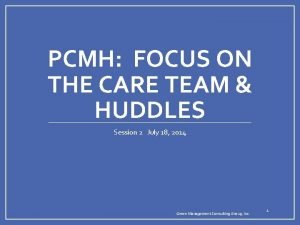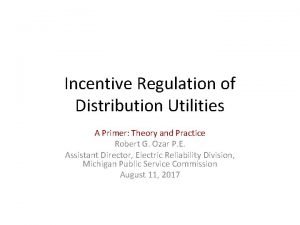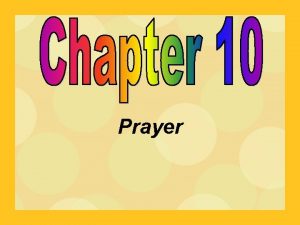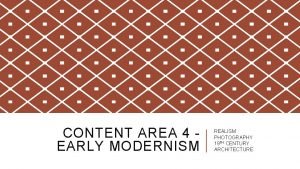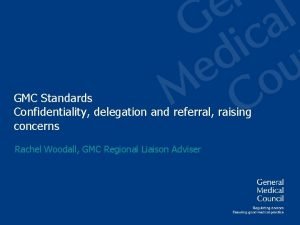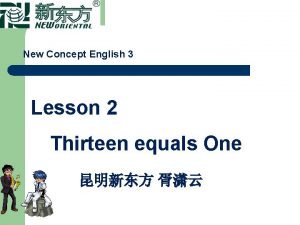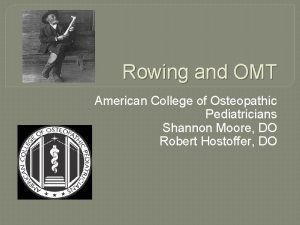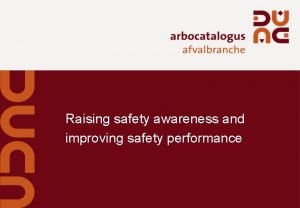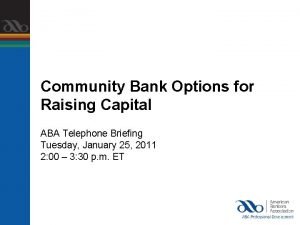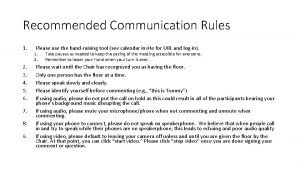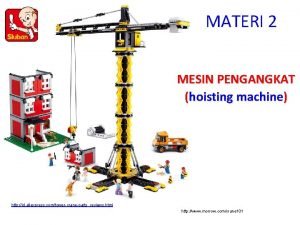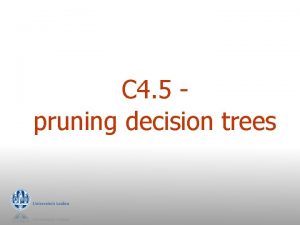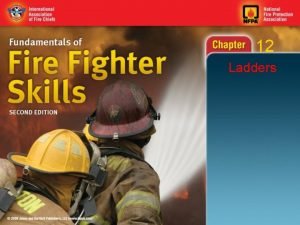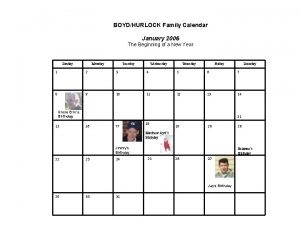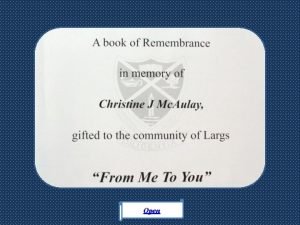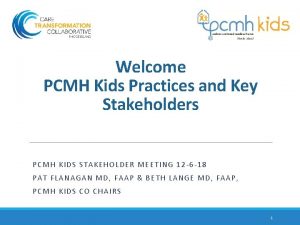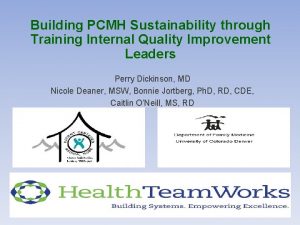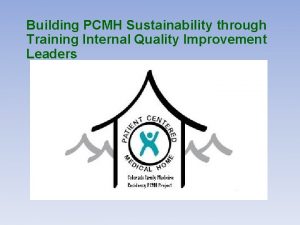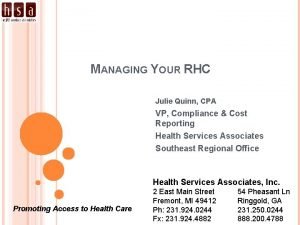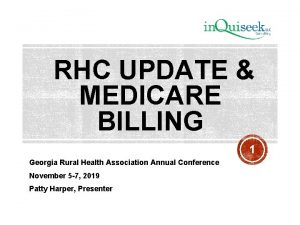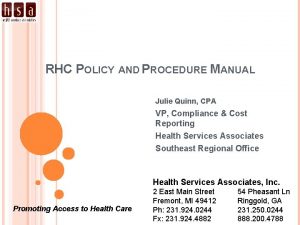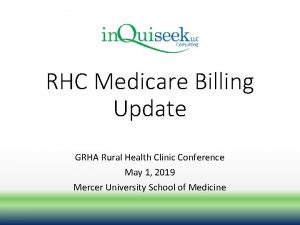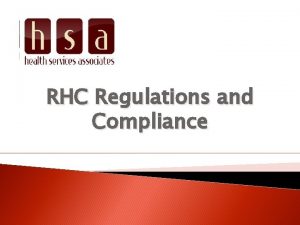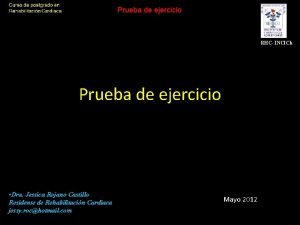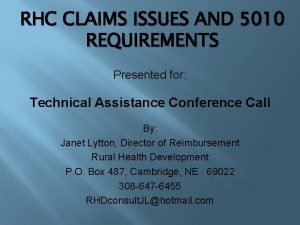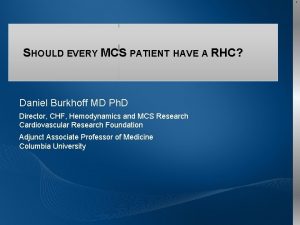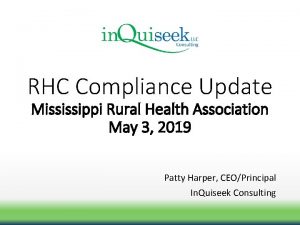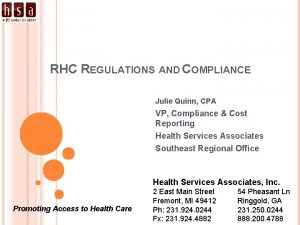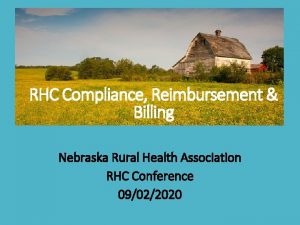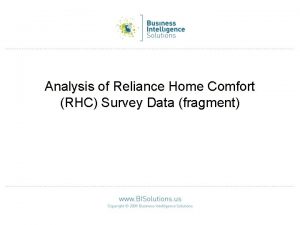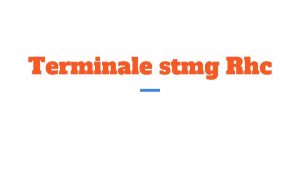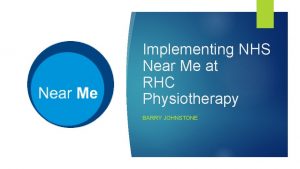April 26 2019 Raising RHC Quality with PCMH




















































- Slides: 52

April 26, 2019 Raising RHC Quality with PCMH Alabama Rural Health Association KATE HILL, RN

Goals for the Day Understand the value of PCMH to your practice General Understanding of the PCMH Standards Learn how to begin the PCMH process in your practice • Have a working knowledge of a PCMH Survey

Elements of the PCMH Model Comprehensive Care Patient Centered Coordinated Care Accessible Services Quality and Safety

What is a Patient Centered Medical Home? Clearly it’s a journey, not a destination!

Why Become a Patient Centered Medical Home • Puts patients first • Make primary care more accessible • Improves staff satisfaction • Improves patient outcomes • Mitigates health disparities • Increase revenue • Become the provider of choice in your community • Consistent reductions of high cost care

Why Become a Patient Centered Medical Home • PCMH as a Value-Based Strategy • Medicare has moved to change how it structures payment from a quantity to a quality approach. It will provide incentives for better processes and outcomes. • Medicaid programs have made enhanced payments to providers who achieved certain distinctions or process measures.

Why Become a Patient Centered Medical Home • Every $1. 00 increase in Primary care spending equals $13. 00 in savings. • This study provides another piece of evidence supporting the hypothesis that PCMH can lead ot lower cost of care. • Nevertheless, this study shows a consistent pattern, suggesting a robust cost saving across all the cost categories. Study shows the PCMH impact on each of the three main components of the total cost: acute inpatient, outpatient, and professional costs. (Geisinger Study)

Barriers to Becoming a Patient Centered Medical Home • Resistance to change • Inadequate financial resources • Low workforce • Low adaptive reserve • Your EHR • Staff buy in • Motivation

Most PCMH Programs can be… • Rigid • Burdensome • Labor Intensive • Expensive • Overwhelming Robs time devoted to patient care.

Rethinking PCMH • Anything taking you away from patient care is heading in the wrong direction! • Our Team’s PCMH Accreditation Program focuses on getting back to patient care and looks at day to day operations. • Its a Winning Approach for both Clinics and Patients.

Good news • RHCs are already doing much of this informally but not getting credit for it. • Becoming a PCMH formalizes the process and identifies performance gaps.

TCT Approach to Quality Standards “Operational excellence leads to clinical excellence. ” – Sandy Canally, RN

Introduction to the TCT Quality Standards TCT PCMH Quality Standards

The Clinic provides advanced access to its patients. • Expanded hours: • Same day appointments for urgent illness. • Some evidence of expanded weekday, evening, and weekend appointment offerings. • Call coverage or arrangement for after-hours emergencies 24/7. • The organization provides patients and their family/caregivers written information regarding the Patient-Centered Medical Home and its services.

PCMH Handouts Create brochures to educate your patients.

PCMH Handouts Create brochures a poster for your waiting room to tell you patients about you Patient Centered Medical Home. Used with permission

The Clinic provides advanced access to its patients. The organization communicates essential practice information to its patients. This information includes: • • What patients should bring to each appointment. How patient calls and prescription requests are handled. The routes in which patients can attain healthcare access after-hours. Policies regarding the rescheduling or cancellation of appointments.

Example: Info for Care After-Hours • Contacting your providers after hours: • Call 911 for emergencies • If you have an urgent questions that cannot wait until regular office hours, you can reach a member of our medical staff 24 hours a day 365 days a year. • Please refer to the following chart for instructions on how to reach your doctor • If you don’t have this information with you, after hours instructions can be provided by calling our clinic phone number when the clinic is closed. • Please note that our on-call providers do not prescribe antibiotics, pain medicine, or ADHD medications over the phone.

The Clinic provides advanced access to its patients. Evidence exists of advanced access through multiple forms of communication with its patients. Examples include: printed handouts, email access, patient portals, website postings, texted information, automated phone messages, and phone calls from the office staff. A written-plan for handling patient communication that includes acceptable time frames for returning patient calls or requests. All calls or requests from patients are documented with date and time. Example: All Rx refill calls returned within 1 business day No Friday afternoon refills are left till Monday

Community Resources • Patients are in your office only a small percentage of their lives, so providers should strive to find resources to meet the needs of patients when they leave the clinic. • Community resources should be used to engage with the clinic’s patient population. Discharge planners and case workers Rehabilitation centers Community outreach programs and clubs Church programs

The Clinic provides advanced access to its patients. • The clinic actively engages with community resources to reach out to its patient population. For example: Discharge planners, Case workers from physical or behavioral healthcare rehabilitation centers, Other healthcare professionals providing services not available in the organization, Community outreach programs, and Community clubs.

Examples of Community Resources

Examples of Community Resources

The Clinic meets the healthcare needs of patients when they are closed. A written agreement with each entity responsible for handling patient healthcare needs after-hours. The agreement identifies the contracted provider’s scope of services, responsibilities for patient care, and hours of operation. • For example:

The Clinic meets the healthcare needs of patients when they are closed. The clinic’s providers receive and review patient healthcare information from after-hours providers. All follow-up is documented in the patient healthcare record.

The Clinic utilizes a team-based approach for patientcentered coordinated care

A team-based approach for patient-centered coordinated care. • New patients are assigned to a primary provider • For continuity of care, subsequent visits are provided by the same provider led care team, unless the primary provider orders a change or the patient requests a change. • Provider led care teams are arranged to meet the needs of the patient population(s) served. For example: Adult, Pediatric, Chronic Care Management, Behavioral Health, and Geriatric Care.

A team-based approach for patient-centered coordinated care. The organization has one or more designated staff members providing Care Coordination interdependently between PCMH Providers, other Healthcare Professionals, and patient care services provided externally. “CARE COORDINATOR” “NURSE NAVIGATOR” “CARE COACH”

Care Coordinator duties include: • Organizing clinical data to support the on-going care of patients, monitoring diagnostic tests, and providing written and/or verbal follow-up on results to patients/caregivers, when clinically indicated. • Working with patients/caregivers to develop written care goals. • Utilizing written protocols with hospitals outlining the referral process and admission and discharge notifications. • Utilizing a system to identify and improve the care of high-risk or special needs patients including: • Daily huddles • Communication boards • Meetings with providers Utilizing written protocols with hospitals outlining the referral process and admission and discharge notifications.

A team-based approach for patient-centered coordinated care. • Providing a summary for patients transferring to another medical provider. • Providing support to patients/caregivers by helping them connect to community resources. Transition Care Management services (as applicable). The Care Coordinator monitors care provided to patients by other providers including: Specialists managing patients’ medications and ordering labs, diagnostics, treatments, procedures, and/or therapies. . Pharmacists regarding patients’ medication history, adherence, and any involvement with medication therapy management.

Huddles

Huddles Start on time, be consistent, have an agenda. Stand to keep the huddle moving along. Forms stronger care team bonds with the patient at the center. Invite each member to share one concern or success from the previous day. Review patients for the day, identify patients who could have quality and safety issues. Identify patients who need community resources. Close the huddle with announcements, schedule changes, or other messages Thank the team.

Patient health records are complete. In addition to the usual elements: • Behavioral health screening when symptoms are identified (e. g. Patient Health Questionnaire (PHQ 2 or 9) for depression); • Cognitive health screening when symptoms are identified or patient is over 65 years of age (e. g. Brief interview of Mental Status (BIMS)); Updated needs assessment (as appropriate); Updated patient-centered health improvement plan™(PCHIP™); and Updated patient health goals. Summary of the encounter and patient instructions. • Documentation and reconciliation of current patient medications (including supplements)and patient allergies. • Identification of provider/care team assigned to the patient.

Patient health records are complete. In addition to the usual elements: Identification of patient’s pharmacy by name, location and contact information. The organization provides an after-visit summary which is given to the patient or is available via a patient portal. The summary includes: Current vital signs; Relevant health Current diagnosis; Current medications; patient instructions; Patient’s short and long-term goals; Name of patient’s Provider and; and PCMH contact information.

Reduce High Cost Primary Care Ambulatory Care ED Utilization Community Resources Home Services Hospitalization

Patient Centered Health Improvement Plans ™(PCHIP) • The PCHIP™ which addresses the current and future needs of the patient from a whole person perspective focusing on all ages and stages of life. • Identify high risk and/or complex patients in the practice. • Provide patient communication and education through the formats identified to meet the unique needs of each patient (e. g. written, audio, video, technology-enabled, and/or the use of interpreters). • The PCHIP ™ address the communication needs of the patient: When a physical or mental impairment or learning disability exists, When English is not the primary language spoken, or When cultural or religious beliefs may impact the delivery of care.

Patient Centered Health Improvement Plans ™(PCHIP) • Utilize a questionnaire or interview technique to identify and update the healthcare goal(s)most important from the patient’s perspective. It needs to determine current healthcare limitations and frustrations that interfere with “what matters most” to the patient at this time in their life. • Needs assessment concerning; the patient’s ability to perform the activities of daily living, safety of the home environment, family/caregiver support system, access to transportation and requirements for healthcare services that cannot be met by the organization.

What Matter Most EXAMPLE: Patient would like to attend grandchild’s wedding, but is unable to do this because she cannot walk long distances without assistance and doesn’t have a wheelchair.

The clinic provides patient education and self-management tools to patients and their families/caregivers. • Self-management tools are offered to the patient to encourage compliance. Examples of self-management tools include: medication management plans, goal-oriented TO DOs, and web-based interactive health programs. • Healthcare education and self-management tools when health problems are diagnosed, treatment is ordered, or risks are identified. • Education and support includes all appropriate persons, per the direction of the patient, in decision-making regarding care.

Self Management Tools

The clinic provides patient education and self-management tools to patients and their families/caregivers.

Self Mangagement Tools

Follow Up is the Key A process to ensure continuity of care in the follow-up of patients regarding: Reminder notification system. Missed patient appointments. Requests for medication refills by patients. High-risk medication(s) or in-home treatment(s) that are newly prescribed. Laboratory or diagnostic results that are abnormal. Referrals and consultations. Preventative care and screening reminders. Care coordination activities. Those patients who frequent the emergency department. Those patients who are discharged from the hospital.

Follow Up is the Key • Memorial Hospital Association in Carthage, IL identified 55 frequent flyers to the ED. • Those 55 were monitored from Jan 1 to March 31, 2017. • An additional bonus was the increase in clinic visits from seeing those 54 patients frequently and mostly on same day appointments. • Results in April showed only one of those patients had been to the ED. • How did they manage that? • The answer is follow up, follow up and then follow up again. • Visits to the clinic increased over those three months. • Savings to payers was huge.

Preventive Health Measures Mammograms Pap Smears Colonoscopy Immunizations PSA Fecal Occult Blood Tobacco Cessation Immunizations

Preventive Health Measures Early and Periodic Screening, Diagnostic and Treatment (EPSDT) is the child health component of Medicaid. Federal statutes and regulations state that children under age 21 who are enrolled in Medicaid are entitled to EPSDT benefits and that States must cover a broad array of preventive and treatment services.

PCMH is Continuous Quality Improvement Is your practice providing: • Better healthcare outcomes for the population served by the organization? • Better service from the organization? • Lower costs for the overall care? QI Review is how to find out…

PCMH Implementation Have an initial meeting with your leadership and providers Figure out the timeline for implementation Have as many staff members as possible attend the webinar for PCMH Quality Standards Print the standards and take notes Don’t reinvent the wheel

Studies show that PCMH: • Make primary care more accessible, comprehensive and coordinated. • Provides better support and communication • Creates stronger relationships with your providers • Improves patient outcomes • Lowers overall healthcare costs

Positive outcomes within 4 months! • “Our patients feel more connected because of all the additional contact. That translated to a feeling that Our patients interpret this to mean we care more than we did” • We focus on patient management during transitions of care to decrease readmission; scheduled, proactive outreach to high-risk patients; and initiatives that support patient self -management of chronic diseases (regular calls and emails to patients). ” • “We receive a daily census of our admitted patients from hospitals. One of the hospitals automatically sends Emergency Dept. , H&P, consult and discharge reports for each transition. Those reports are faxed, and the MAs ensure timely transfer of data to tracking spreadsheets. ” • “I interview the patient and family and figure out the holistic needs of the patient. Spending time with outreach programs arranging transportation and Meals on Wheels can make a difference in keeping a chronically ill patient out of the hospital. Its not always medication management, ” • “I feel like a nurse again”

Positive outcomes within 4 months! • And the best one: “Great medicine is being done outside the patient visit. mostly in follow up activities”

Get in Touch! Kate Hill, RN 215 -654 -9110 khill@thecomplianceteam. org Questions? ? ?
 Rhc
Rhc Palominas rural clinic
Palominas rural clinic Rhc
Rhc Pcmh huddle template
Pcmh huddle template Disadvantage of raising minimum wage
Disadvantage of raising minimum wage Physical raising agents
Physical raising agents Chloe delgado
Chloe delgado Raising capital definition
Raising capital definition Prayer is the raising of the heart and mind to god
Prayer is the raising of the heart and mind to god Raising attainment
Raising attainment Raising of the mary rose
Raising of the mary rose Michael shurtleff 12 guideposts
Michael shurtleff 12 guideposts Nadar raising photography to the height of art
Nadar raising photography to the height of art Gmc confidentiality
Gmc confidentiality Throat paints are ………. liquid preparations. *
Throat paints are ………. liquid preparations. * New concept english 3
New concept english 3 Overlord raising hell heaven's peak abyss
Overlord raising hell heaven's peak abyss Describe preindustrial societies of horticulturalists.
Describe preindustrial societies of horticulturalists. Rib raising omt
Rib raising omt Awareness raising tv spot
Awareness raising tv spot Raising safety awareness
Raising safety awareness Community bank capital raising
Community bank capital raising Unit 9 raising finance answers
Unit 9 raising finance answers Raising an auto in a service station
Raising an auto in a service station Raising lazarus from the dead – john 11.1-44
Raising lazarus from the dead – john 11.1-44 Tohru raising the floor
Tohru raising the floor Raising a godly child in an ungodly world
Raising a godly child in an ungodly world Raising machine
Raising machine Subtree raising
Subtree raising Nadar raising photography to the height of art
Nadar raising photography to the height of art Ladder raising and proper climbing angle
Ladder raising and proper climbing angle Define seminar in nursing management
Define seminar in nursing management Quality is free: the art of making quality certain
Quality is free: the art of making quality certain Quality control and quality assurance
Quality control and quality assurance Compliance vs quality
Compliance vs quality What is tqm
What is tqm Pmp quality management
Pmp quality management Qa basic concepts
Qa basic concepts Pmp gold plating
Pmp gold plating Philip crosby formulated the seven deadly diseases
Philip crosby formulated the seven deadly diseases April 23 1564
April 23 1564 April piscids
April piscids January 2006 calendar
January 2006 calendar What is april dedicated to
What is april dedicated to Dreißig tage hat september
Dreißig tage hat september April 23 1564
April 23 1564 April 8th in history
April 8th in history Reformdjp/quiz/kuis-mini-april
Reformdjp/quiz/kuis-mini-april January february march april may
January february march april may 23 april shakespeare
23 april shakespeare Apod nasa calendar 26 april 2004
Apod nasa calendar 26 april 2004 Sonnet 64
Sonnet 64 April raintree summary
April raintree summary
